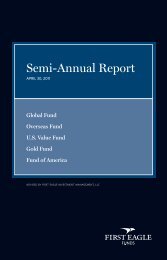Inside this Issue - First Eagle Funds
Inside this Issue - First Eagle Funds
Inside this Issue - First Eagle Funds
Create successful ePaper yourself
Turn your PDF publications into a flip-book with our unique Google optimized e-Paper software.
Is patience a key with <strong>this</strong> investment?<br />
MM: As a capital-goods provider in the<br />
worst recession in the post-war period,<br />
the company is not going to have anything<br />
impressive in the way of earnings<br />
power over the next 12 months. But if<br />
you take a longer-term perspective,<br />
through previous cycles Fanuc has generated<br />
mid-30% EBIT margins, which<br />
given the strength of its market positions<br />
we fully expect to return. We don’t have<br />
to get the timing of the recovery<br />
absolutely right because there are no<br />
financial contingencies – approximately<br />
one-third of the company’s market cap is<br />
in net cash.<br />
How cheap are the shares, trading now at<br />
just under ¥7,800?<br />
INVESTMENT SNAPSHOT<br />
Fanuc<br />
(Tokyo: 6954:JP)<br />
Business: Global manufacturer of factory<br />
automation systems and equipment, including<br />
computerized numerically controlled<br />
equipment, servo motors and robotics.<br />
Share Information<br />
(@6/30/09, Exchange Rate: $1 = ¥95.915):<br />
Price ¥7,760<br />
52-Week Range ¥4,800 – ¥10,800<br />
Dividend Yield 1.8%<br />
Market Cap ¥1.86 trillion<br />
FANUC HISTORY<br />
15000<br />
12000<br />
9000<br />
6000<br />
3000<br />
June 30, 2009<br />
MM: Stripping out the cash, you’re paying<br />
around ¥5,000 per share for the operating<br />
business, which has generated in the<br />
best times more than ¥600 in earnings per<br />
share. If you normalize that to ¥450-500<br />
per share, you’re only paying 10-11x EPS.<br />
On normalized EBIT, the multiple is<br />
around 7x.<br />
That’s a very conservative price to pay<br />
for a business with dominant market<br />
share and excellent growth prospects,<br />
which in more normal times could be<br />
expected to trade at closer to 15x EBIT.<br />
There’s a need for <strong>this</strong> technology over<br />
time, evidenced by the fact that each successive<br />
peak in Fanuc’s earnings power<br />
over the last few cycles has been substantially<br />
higher than the prior one. There’s<br />
no reason <strong>this</strong> business can’t earn ¥1,000<br />
per share at some point.<br />
THE BOTTOM LINE<br />
The market’s short-term focus is undervaluing the company’s potential to translate leading<br />
market positions and key intellectual property into strong profit growth as the global<br />
economy mends, says Matt McLennan. At a reasonable multiple of 15x his estimate of<br />
the company’s normalized EBIT, the shares would be worth twice their current value.<br />
Sources: Company reports, other publicly available information<br />
Financials (FY2008)<br />
Revenue ¥468.40 billion<br />
Operating Profit Margin 40.5%<br />
Net Profit Margin 27.1%<br />
Valuation Metrics<br />
(Current Price vs. TTM):<br />
FANUC S&P 500<br />
P/E 16.6 35.4<br />
2007 2008 2009<br />
www.valueinvestorinsight.com<br />
15000<br />
12000<br />
9000<br />
6000<br />
3000<br />
INVESTOR INSIGHT: <strong>First</strong> <strong>Eagle</strong><br />
If we were growth investors, we’d be<br />
out there looking at the penetration of<br />
CNC systems in China ten years out and<br />
then trying to figure out how much<br />
Fanuc would benefit from that. We don’t<br />
have to make those types of precise forecasts<br />
– the stock is currently cheap based<br />
on what they’ve already demonstrated<br />
they can do.<br />
How would you characterize management’s<br />
concern for shareholders?<br />
MM: On the surface, Fanuc seems like<br />
the prototypical company that people<br />
rightly complain about: too much cash<br />
on the balance sheet, no external directors,<br />
not much interaction with the<br />
Street. On the other hand, though, you<br />
have an extremely experienced management<br />
team that has built a very strong<br />
culture and that takes a generational<br />
view in how they do things. The mission<br />
is for the company to live forever, but at<br />
the same time they’ve shown a clear ability<br />
to produce high cash flow through the<br />
cycle. If we can buy into a company like<br />
that at the right price, that’s very appealing<br />
to us.<br />
Staying in Japan, explain your interest in<br />
pharmaceutical company Astellas<br />
[4503:JP].<br />
MM: Astellas isn’t one of the betterknown<br />
global pharmaceutical companies<br />
– it is the product of a merger five years<br />
ago between Yamanouchi Pharmaceutical<br />
and Fujisawa Healthcare – but it generates<br />
nearly ¥1 trillion in annual revenue<br />
[approximately $10 billion] from a portfolio<br />
of 18 drugs, with particular strength<br />
in immunology and urology. It has the<br />
largest salesforce in Japan, distributing<br />
drugs there for others, including Lipitor<br />
for Pfizer.<br />
The company also has a large newproduct<br />
pipeline, with 18 molecules that<br />
are in either Phase 2 or Phase 3 testing.<br />
Roughly half of the pipeline drugs are<br />
focused on areas in which the company<br />
already has a large presence, but the rest<br />
target new areas like diabetes and cardiovascular<br />
treatment.<br />
Value Investor Insight 5



